[English] 日本語
 Yorodumi
Yorodumi- EMDB-35610: Cryo-EM structure of phosphoketolase from Bifidobacterium longum ... -
+ Open data
Open data
- Basic information
Basic information
| Entry |  | |||||||||
|---|---|---|---|---|---|---|---|---|---|---|
| Title | Cryo-EM structure of phosphoketolase from Bifidobacterium longum in dimeric assembly | |||||||||
 Map data Map data | ||||||||||
 Sample Sample |
| |||||||||
 Keywords Keywords | Carbon metabolism / TPP-dependent enzyme /  CYTOSOLIC PROTEIN CYTOSOLIC PROTEIN | |||||||||
| Function / homology |  Function and homology information Function and homology information | |||||||||
| Biological species |  Bifidobacteriaceae bacterium (bacteria) / Bifidobacteriaceae bacterium (bacteria) /   Bifidobacterium longum subsp. longum F8 (bacteria) Bifidobacterium longum subsp. longum F8 (bacteria) | |||||||||
| Method |  single particle reconstruction / single particle reconstruction /  cryo EM / Resolution: 2.62 Å cryo EM / Resolution: 2.62 Å | |||||||||
 Authors Authors | Chang C-W / Tsai M-D | |||||||||
| Funding support |  Taiwan, 2 items Taiwan, 2 items
| |||||||||
 Citation Citation |  Journal: Nat Metab / Year: 2023 Journal: Nat Metab / Year: 2023Title: An ATP-sensitive phosphoketolase regulates carbon fixation in cyanobacteria. Authors: Kuan-Jen Lu / Chiung-Wen Chang / Chun-Hsiung Wang / Frederic Y-H Chen / Irene Y Huang / Pin-Hsuan Huang / Cheng-Han Yang / Hsiang-Yi Wu / Wen-Jin Wu / Kai-Cheng Hsu / Meng-Chiao Ho / Ming- ...Authors: Kuan-Jen Lu / Chiung-Wen Chang / Chun-Hsiung Wang / Frederic Y-H Chen / Irene Y Huang / Pin-Hsuan Huang / Cheng-Han Yang / Hsiang-Yi Wu / Wen-Jin Wu / Kai-Cheng Hsu / Meng-Chiao Ho / Ming-Daw Tsai / James C Liao /  Abstract: Regulation of CO fixation in cyanobacteria is important both for the organism and global carbon balance. Here we show that phosphoketolase in Synechococcus elongatus PCC7942 (SeXPK) possesses a ...Regulation of CO fixation in cyanobacteria is important both for the organism and global carbon balance. Here we show that phosphoketolase in Synechococcus elongatus PCC7942 (SeXPK) possesses a distinct ATP-sensing mechanism, where a drop in ATP level allows SeXPK to divert precursors of the RuBisCO substrate away from the Calvin-Benson-Bassham cycle. Deleting the SeXPK gene increased CO fixation particularly during light-dark transitions. In high-density cultures, the Δxpk strain showed a 60% increase in carbon fixation and unexpectedly resulted in sucrose secretion without any pathway engineering. Using cryo-EM analysis, we discovered that these functions were enabled by a unique allosteric regulatory site involving two subunits jointly binding two ATP, which constantly suppresses the activity of SeXPK until the ATP level drops. This magnesium-independent ATP allosteric site is present in many species across all three domains of life, where it may also play important regulatory functions. | |||||||||
| History |
|
- Structure visualization
Structure visualization
| Supplemental images |
|---|
- Downloads & links
Downloads & links
-EMDB archive
| Map data |  emd_35610.map.gz emd_35610.map.gz | 106.9 MB |  EMDB map data format EMDB map data format | |
|---|---|---|---|---|
| Header (meta data) |  emd-35610-v30.xml emd-35610-v30.xml emd-35610.xml emd-35610.xml | 17.3 KB 17.3 KB | Display Display |  EMDB header EMDB header |
| FSC (resolution estimation) |  emd_35610_fsc.xml emd_35610_fsc.xml | 13.8 KB | Display |  FSC data file FSC data file |
| Images |  emd_35610.png emd_35610.png | 118.9 KB | ||
| Filedesc metadata |  emd-35610.cif.gz emd-35610.cif.gz | 6.4 KB | ||
| Others |  emd_35610_half_map_1.map.gz emd_35610_half_map_1.map.gz emd_35610_half_map_2.map.gz emd_35610_half_map_2.map.gz | 200.6 MB 200.6 MB | ||
| Archive directory |  http://ftp.pdbj.org/pub/emdb/structures/EMD-35610 http://ftp.pdbj.org/pub/emdb/structures/EMD-35610 ftp://ftp.pdbj.org/pub/emdb/structures/EMD-35610 ftp://ftp.pdbj.org/pub/emdb/structures/EMD-35610 | HTTPS FTP |
-Related structure data
| Related structure data | 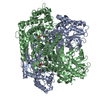 8io7MC 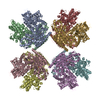 8io6C 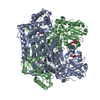 8io8C 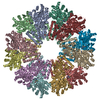 8io9C  8ioaC  8ioeC M: atomic model generated by this map C: citing same article ( |
|---|---|
| Similar structure data | Similarity search - Function & homology  F&H Search F&H Search |
- Links
Links
| EMDB pages |  EMDB (EBI/PDBe) / EMDB (EBI/PDBe) /  EMDataResource EMDataResource |
|---|---|
| Related items in Molecule of the Month |
- Map
Map
| File |  Download / File: emd_35610.map.gz / Format: CCP4 / Size: 216 MB / Type: IMAGE STORED AS FLOATING POINT NUMBER (4 BYTES) Download / File: emd_35610.map.gz / Format: CCP4 / Size: 216 MB / Type: IMAGE STORED AS FLOATING POINT NUMBER (4 BYTES) | ||||||||||||||||||||
|---|---|---|---|---|---|---|---|---|---|---|---|---|---|---|---|---|---|---|---|---|---|
| Voxel size | X=Y=Z: 0.83 Å | ||||||||||||||||||||
| Density |
| ||||||||||||||||||||
| Symmetry | Space group: 1 | ||||||||||||||||||||
| Details | EMDB XML:
|
-Supplemental data
-Half map: #1
| File | emd_35610_half_map_1.map | ||||||||||||
|---|---|---|---|---|---|---|---|---|---|---|---|---|---|
| Projections & Slices |
| ||||||||||||
| Density Histograms |
-Half map: #2
| File | emd_35610_half_map_2.map | ||||||||||||
|---|---|---|---|---|---|---|---|---|---|---|---|---|---|
| Projections & Slices |
| ||||||||||||
| Density Histograms |
- Sample components
Sample components
-Entire : Bifidobacterium longum XFPK in complex with TPP/Mg2+
| Entire | Name: Bifidobacterium longum XFPK in complex with TPP/Mg2+ |
|---|---|
| Components |
|
-Supramolecule #1: Bifidobacterium longum XFPK in complex with TPP/Mg2+
| Supramolecule | Name: Bifidobacterium longum XFPK in complex with TPP/Mg2+ / type: complex / ID: 1 / Parent: 0 / Macromolecule list: #1 |
|---|---|
| Source (natural) | Organism:  Bifidobacteriaceae bacterium (bacteria) Bifidobacteriaceae bacterium (bacteria) |
| Molecular weight | Theoretical: 750 KDa |
-Macromolecule #1: Xylulose5phosphatefructose6phosphate phosphoketolase
| Macromolecule | Name: Xylulose5phosphatefructose6phosphate phosphoketolase / type: protein_or_peptide / ID: 1 / Number of copies: 2 / Enantiomer: LEVO |
|---|---|
| Source (natural) | Organism:   Bifidobacterium longum subsp. longum F8 (bacteria) Bifidobacterium longum subsp. longum F8 (bacteria) |
| Molecular weight | Theoretical: 92.621125 KDa |
| Recombinant expression | Organism:   Escherichia coli (E. coli) Escherichia coli (E. coli) |
| Sequence | String: MTSPVIGTPW KKLNAPVSEE ALEGVDKYWR VANYLSIGQI YLRSNPLMKE PFTREDVKHR LVGHWGTTPG LNFLIGHINR FIADHGQNT VIIMGPGHGG PAGTSQSYLD GTYTETFPKI TKDEAGLQKF FRQFSYPGGI PSHFAPETPG SIHEGGELGY A LSHAYGAI ...String: MTSPVIGTPW KKLNAPVSEE ALEGVDKYWR VANYLSIGQI YLRSNPLMKE PFTREDVKHR LVGHWGTTPG LNFLIGHINR FIADHGQNT VIIMGPGHGG PAGTSQSYLD GTYTETFPKI TKDEAGLQKF FRQFSYPGGI PSHFAPETPG SIHEGGELGY A LSHAYGAI MDNPSLFVPA IVGDGEAETG PLATGWQSNK LVNPRTDGIV LPILHLNGYK IANPTILSRI SDEELHEFFH GM GYEPYEF VAGFDDEDHM SIHRRFAELW ETIWDEICDI KATAQTDNVH RPFYPMLIFR TPKGWTCPKY IDGKKTEGSW RSH QVPLAS ARDTEAHFEV LKNWLESYKP EELFDANGAV KDDVLAFMPK GELRIGANPN ANGGVIRNDL KLPNLEDYEV KEVA EYGHG WGQLEATRTL GAYTRDIIKN NPRDFRIFGP DETASNRLQA SYEVTNKQWD AGYISDEVDE HMHVSGQVVE QLSEH QMEG FLEAYLLTGR HGIWSSYESF VHVIDSMLNQ HAKWLEATVR EIPWRKPIAS MNLLVSSHVW RQDHNGFSHQ DPGVTS VLL NKCFHNDHVI GIYFATDANM LLAIAEKCYK STNKINAIIA GKQPAATWLT LDEARAELEK GAAAWDWAST AKNNDEA EV VLAAAGDVPT QEIMAASDKL KELGVKFKVV NVADLLSLQS AKENDEALTD EEFADIFTAD KPVLFAYHSY AHDVRGLI Y DRPNHDNFNV HGYEEEGSTT TPYDMVRVNR IDRYELTAEA LRMIDADKYA DKIDELEKFR DEAFQFAVDN GYDHPDYTD WVYSGVNTDK KGAVTATAAT AGDNE UniProtKB: Xylulose5phosphatefructose6phosphate phosphoketolase |
-Macromolecule #2: THIAMINE DIPHOSPHATE
| Macromolecule | Name: THIAMINE DIPHOSPHATE / type: ligand / ID: 2 / Number of copies: 2 / Formula: TPP |
|---|---|
| Molecular weight | Theoretical: 425.314 Da |
| Chemical component information | 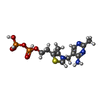 ChemComp-TPP: |
-Macromolecule #3: MAGNESIUM ION
| Macromolecule | Name: MAGNESIUM ION / type: ligand / ID: 3 / Number of copies: 2 / Formula: MG |
|---|---|
| Molecular weight | Theoretical: 24.305 Da |
-Experimental details
-Structure determination
| Method |  cryo EM cryo EM |
|---|---|
 Processing Processing |  single particle reconstruction single particle reconstruction |
| Aggregation state | particle |
- Sample preparation
Sample preparation
| Concentration | 0.4 mg/mL |
|---|---|
| Buffer | pH: 7.2 |
| Grid | Model: Quantifoil R1.2/1.3 / Material: COPPER / Mesh: 300 / Pretreatment - Type: GLOW DISCHARGE / Pretreatment - Time: 40 sec. |
| Vitrification | Cryogen name: ETHANE |
- Electron microscopy
Electron microscopy
| Microscope | FEI TITAN KRIOS |
|---|---|
| Electron beam | Acceleration voltage: 300 kV / Electron source:  FIELD EMISSION GUN FIELD EMISSION GUN |
| Electron optics | Illumination mode: FLOOD BEAM / Imaging mode: BRIGHT FIELD Bright-field microscopy / Cs: 2.7 mm / Nominal defocus max: 2.5 µm / Nominal defocus min: 1.5 µm / Nominal magnification: 105000 Bright-field microscopy / Cs: 2.7 mm / Nominal defocus max: 2.5 µm / Nominal defocus min: 1.5 µm / Nominal magnification: 105000 |
| Sample stage | Specimen holder model: FEI TITAN KRIOS AUTOGRID HOLDER / Cooling holder cryogen: NITROGEN |
| Image recording | Film or detector model: GATAN K3 BIOQUANTUM (6k x 4k) / Detector mode: SUPER-RESOLUTION / Number grids imaged: 1 / Number real images: 6289 / Average exposure time: 2.5 sec. / Average electron dose: 42.0 e/Å2 |
| Experimental equipment |  Model: Titan Krios / Image courtesy: FEI Company |
 Movie
Movie Controller
Controller








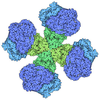


 Z
Z Y
Y X
X



















